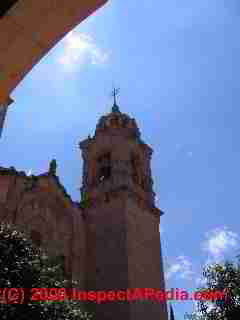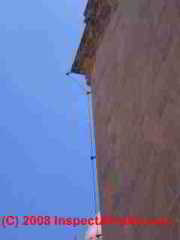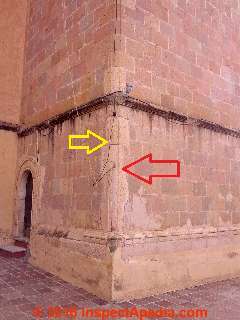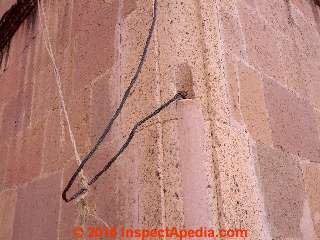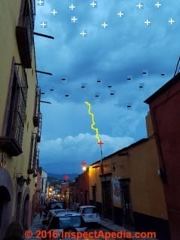 How do Lightning Systems Work?
How do Lightning Systems Work?
How does a lightning protection system avoid strike damage?
- POST a QUESTION or COMMENT about how lightning protection systems actually work.
How does a lightning protection system actually work?
This article describes how a lightning protection system conducts the electrical charge of a lightning strike to earth to reduce the chances of costly damage to a building or its systems.
This article series describes common lightning protection systems, certification, installation, and lightning protection system inspection. We provide information about lightning strikes, lightning hazards, related equipment, sources of lightning protection system installers, and lightning strike risk assessment
InspectAPedia tolerates no conflicts of interest. We have no relationship with advertisers, products, or services discussed at this website.
- Daniel Friedman, Publisher/Editor/Author - See WHO ARE WE?
How do Lightning Protection Systems Work?
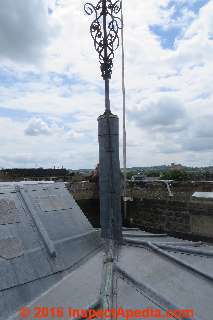 This article series , in two parts, describes first how a lightning strike forms and moves between a storm cloud and objects on the earth's surface, and second, how a lightning protection system installed on a church, tree, tower or other tall object reduces the chance of lightning damage by conducing the lightning strike more-safely to earth.
This article series , in two parts, describes first how a lightning strike forms and moves between a storm cloud and objects on the earth's surface, and second, how a lightning protection system installed on a church, tree, tower or other tall object reduces the chance of lightning damage by conducing the lightning strike more-safely to earth.
Our photo shows the ornate lightning rod atop the Saxon Tower in Oxford in the U.K.
[Click to enlarge any image]
The actual lightning rod is mounted at the apex of a metal (lead) roof capping part of the Saxon Tower roof.
A thick braided copper cable is bonded to the bottom of the lightning rod.
That cable in turn extends down the tower to earth where it is bonded to a driven electrode that enables the system to conduct a lightning strike to earth while minimizing the risk of lightning damage to the tower itself.
How a Lightning Protection System More-Safely Conducts Lightning Strikes to Earth
Here we use the lightning protection system installed on a church tower as an example to illustrate the simple components of a lightning protection system.
Other articles in this series discuss these components in various installations and in added detail.
Our photo of la Iglesia Valencia in Guanajuato, Mexico, shows a large iron filigree cross atop the church bell tower.
Our photo at above left shows the lightning protection system cabling running along the corner of the Valencia Church steeple in Guanajuato, Mexico.
This church, la Valencia, is located on a high hilltop in a mountainous area where lightning strikes are common.
Although there is no record of his having traveled to Mexico in the course of his tests involving lightning, the lightning protection system was first invented by Ben Franklin in 1752.
Franklin proposed two purposes of a lightning rod:
- Lightning dissipation: the lightning rod may prevent a cloud from releasing a lightning bolt at all by reducing the earth-level static charge being formed by the storm and lightning process described above.
By conducing the developing static charge at the earth's surface - at least in the vicinity of the tall object being protected by the lightning rod - the static charge is reduced and we slow or stop entirely the formation of the rising streamer.
Franklin and other early lightning researchers thought that lightning dissipation was the most-important function of lightning protection systems. Modern physicists disagree, pointing out that the ionized air charge dissipation effect of a lightning protection system only affects the air a few meters around the tip of the lightning rod itself.
This area is trivially small compared with a kilometer-sized and electrically-charged space between the lightning rod and the underside of the storm cloud. - Lightning diversion: the lightning rod combined with cable and ground rod (parts we detail just below) provides a very good conductor (having very low electrical resistance) between the lightning rod atop the protected object (church steeple or something else) and the earth.
Thus if a lightning strike does begin to form between the protected object and the cloud, the lightning protection system conducts that electrical energy safely to earth.
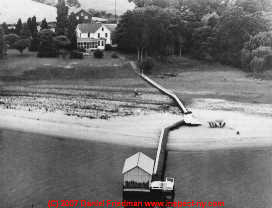 Otherwise that same energy would pass through the protected object itself, almost certainly causing more serious damage or perhaps a fire as well.
Otherwise that same energy would pass through the protected object itself, almost certainly causing more serious damage or perhaps a fire as well.
As a child living in Dunnsville on the Rappahannock river in Virginia I sat on our screened porch (on the house shown here) on a high riverbank as we watched thunderstorms move up the river from Tappahannock.
More than once we watched as lightning struck and literally exploded trees on the riverbank near our home. Without a lightning protection system on the tree, when it participated in a lightning strike the heat caused by the tremendous electrical energy flowing through the tree vaporized its sap and blew the tree in half or into smithereens.
The same energy that causes air to heat and expand to create thunder vaporizes a tree or blows apart masonry blocks of a church steeple if it participates in a lightning strike unprotected by a lightning protection system.
More than a century ago the Valenciana church in Guanajuato installed a lightning protection system which encompasses these simple parts.
- An iron cross atop the church steeple (photo at the start of this section) acts as an air terminal. When weather conditions create a lightning strike that would occur on or close to the church steeple, the air terminal provides an attracting strike point.
Air terminals (rods - the sketch at page top is of a lightning protection system terminal rod tip) are fastened to the building to intercept electric discharges which might otherwise strike a building component itself, such as a chimney or metal roof. - Cabling from the iron cross is routed to ground as we show in a photograph just below. That heavy cabling safely conducts the very high voltage of the lightning strike safely to earth.
Electrical discharges striking the air terminal are directed through heavy duty metal conductors to a grounding system (rods driven into the soil) and thence into the earth.
In our photo below, the yellow arrow points to the lightning protection system cable near the base of the church tower, while the red arrow shows how the tower masons constructed a hollow tubular corner on the tower through which the lightning arrestor cable passes down to reach contact with the earth below the paved area around the tower.
In sum, lightning protection systems control electrical discharges by directing them through a low-resistance path to the ground, avoiding passage through parts of a structure and reducing risk of fire or other damage.
Proper electrical bonding of all of the metal components of the lightning protection system, including lightning rod to cable and cable to ground rod that is driven into the earth, is critical for safe system operation. [Click to enlarge any image]
Watch out: Our OPINION is that if the bonding of a lightning rod system may have been interrupted the presence of the thus incomplete lightning protection system on the building might increase the risk that the building will be damaged by a lightning strike.
When I took these lightning protection system photos (in 2012) someone had pulled out a loose loop in the lightning protection cable and was using it to secure the end of the bell pull rope.
When I see a loose loop in a lightning protection system conductor and when I can't see the grounded end of the cable I'm worried that the system may have been damaged and may be ineffective. Happily, when we last checked in 2016, the tower remained intact.
Examples of proper and improper lightning protection system installation are given throughout this article series.
...
Continue reading at LIGHTNING PROTECTION SYSTEMS - topic home, or select a topic from the closely-related articles below, or see the complete ARTICLE INDEX.
Or see these
Recommended Articles
Suggested citation for this web page
LIGHTNING PROTECTION, HOW IT WORKS at InspectApedia.com - online encyclopedia of building & environmental inspection, testing, diagnosis, repair, & problem prevention advice.
Or see this
INDEX to RELATED ARTICLES: ARTICLE INDEX to LIGHTNING PROTECTION SYSTEMS
Or use the SEARCH BOX found below to Ask a Question or Search InspectApedia
Ask a Question or Search InspectApedia
Try the search box just below, or if you prefer, post a question or comment in the Comments box below and we will respond promptly.
Search the InspectApedia website
Note: appearance of your Comment below may be delayed: if your comment contains an image, photograph, web link, or text that looks to the software as if it might be a web link, your posting will appear after it has been approved by a moderator. Apologies for the delay.
Only one image can be added per comment but you can post as many comments, and therefore images, as you like.
You will not receive a notification when a response to your question has been posted.
Please bookmark this page to make it easy for you to check back for our response.
IF above you see "Comment Form is loading comments..." then COMMENT BOX - countable.ca / bawkbox.com IS NOT WORKING.
In any case you are welcome to send an email directly to us at InspectApedia.com at editor@inspectApedia.com
We'll reply to you directly. Please help us help you by noting, in your email, the URL of the InspectApedia page where you wanted to comment.
Citations & References
In addition to any citations in the article above, a full list is available on request.
- Heidler, F., W. Zischank, Z. Flisowski, Ch Bouquegneau, and C. Mazzetti. "Parameters of lightning current given in IEC 62305-background, experience and outlook." [PDF] In 29th International Conference on Lightning Protection, vol. 23, p. 26. 2008.
Abstract:
The paper reviews the various types of lightning ground flashes, the current components relevant for protection and the current parameters obtained from measurements. On the basis of these measurements, some background information is given how TC 81 selected the parameters published in IEC 62305-1. Finally, methods to simulate lightning currents in laboratory are presented which allow the verification of lightning protection measures or components. - Portions of this information are based on UL publication 200-81 11/87 and other local service company information about lightning protection systems and lightning strike hazards.
- Special thanks to Associated Lightning Rod Company, Cooper Road Box 329A, Millerton NY who has been contributing technical content in presentations to NY ASHI home inspectors since 1996. Some of that information [on lightning system material and installation details] was edited for clarity. ALRCi can be reached at 518-789-4603, 845-373-8309, 860-364-1498 and will inspect your lightning protection system at no charge. [We have no financial nor any other business relationship with any company or product discussed at this website--DF]
- For more details on how lightning protection systems work, see Lightning Protection from Pacific Electric and Gas Company, and Electrical System Grounding and Lightning Protection, Engineering Technical Letter 90-6, Department of the Air Force, HQ USAF.
- Henderson, Tom, "Lightning, static electricity, lesson 4, electric fields", The Physics Classroom, Email: physicsclassroom@comcast.net, retrieved 2016/07/24, original source: http://www.physicsclassroom.com/class/estatics/Lesson-4/Lightning
- Lightning strike risk assessment: for the full body of this excellent article which summarizes recent opinions about lightning strike risk assessment and safe practices for individuals or groups needing to avoid being struck by lightning, see Updated Recommendations for Lightning Safety - 1998 Ronald L. Holle and Raul E. Lopez from National Severe Storms Laboratory, NOAA and Norman, Oklahoma, Christoph Zimmermann Global Atmospherics, Inc. Tucson, Arizona
- As we indicated in an original version of this article, a lightning strike risk assessment guide can be found in Appendix I of the National Fire Protection Association's Lightning Protection Code, NFPA #780. The guide considers type of structure, type of construction, structure location, topography, occupancy, contents and lightning frequency. Contact NFPA, Batterymarch Park, Quincy, MA 02269 617-770-3000.
- Lightning Protection Institute, 3365 N. Arlington Heights Rd., Suite J., Arlington Heights IL 60004
- Underwriters Laboratory Standard UL96A. These requirements cover the installation of lightning protection systems on all types of structures other than structures used for the production, handling, or storage of ammunition, explosives, flammable liquids or gases, and other explosive ingredients including dust. These requirements apply to lightning protection systems that are complete and cover all parts of a structure. Partial systems are not covered by this standard. These requirements do not cover the installation of lightning protection systems for electrical generating, distribution, or transmission systems. These requirements do not cover lightning protection components, which are covered by the Standard for Lightning Protection Components, UL 96.
- Underwriters Laboratory Standard UL96: These requirements cover lightning protection components for use in the installation of complete systems of lightning protection on buildings and structures. These requirements do not cover the installation of lightning protection components. Products of this type are covered by the Standard for Installation Requirements for Lightning Protection Systems, UL 96A.
- "Lightning Awareness," Gerry Schulte, BMW ON magazine, June 2007 pp. 58-60, provided some technical details about lightning, and refers readers to www.lightningsafety.noaa.gov/outdoors.htm
- "Lightning", retrieved 2016/07/25, original source: https://en.wikipedia.org/wiki/Lightning
- "Atmospheric electricity", retrieved 2016/07/27, original source: https://en.wikipedia.org/wiki/Atmospheric_electricity
Wikipedia provided background information about some topics discussed at this website provided this citation is also found in the same article along with a " retrieved on" date. Because Wikipedia and other website entries can be amended in real time, we cite the retrieval date of such citations and we do not assert that the information found there is always authoritative. - Rakov, Vladimir A., and Martin A. Uman. Lightning: physics and effects. Cambridge University Press, 2003.
Excerpt:
Page 17: "1.4. The global electric circuit . Shortly after the experiment at Marly that confirmed Franklin’s conjecture regarding the electrical nature of thunderstorms (Section 1.1), Lemonnier (1752) discovered atmospheric electrical effects in fair weather. Further research established that the Earth’s surface is charged negatively and the air is charged positively, the associated vertical electric field in fair weather being about 100 V m−1 near the Earth’s surface." (A.Rakov & A. Uman, 2003) - Our recommended books about building & mechanical systems design, inspection, problem diagnosis, and repair, and about indoor environment and IAQ testing, diagnosis, and cleanup are at the InspectAPedia Bookstore. Also see our Book Reviews - InspectAPedia.
- Armor Lightning Protection Inc Manchester Center, VT, 802-375-0266 state-of-the-art lightning protection and surge protection for residential and commercial buildings in Vermont, New England, and throughout the Northeast
- Associated Lightning Rod Company, Inc., Box 329A, Cooper Road, Millerton, NY 12546 914/373-8309 518/789-4603
- A-C Lightning Security, Inc., 2100 East First St., PO Box 329, Maryville MO 64468 816-582-8115 800-821-5575 816-562-2932. In New York, Hudson Valley, contact Christensen Electrical Power Systems, Richard G. Christensen, 518-537-4128.
- Lightning Eliminators & Consultants6687 Arapahoe Road Boulder, CO 80303 (303) 447-2828. "Engineering Solutions For Lightning, Grounding and Surge Protection Worldwide Since 1971"
- Electrical EINET
- Lightning Protection for Facilities, Dr. Bruce Gabrielson, Robert B. Marcus, Published and presented: EMCEXPO92, Washington D.C.
- MIT's Electrical Safety Files
- Lightning Protection for Workers What to Do if You're Outside in a Lightning Storm - Center to Protect Workers' Rights (PDF)
- 1998 and Current Lightning Protection Conferences & Exhibitions
- Lightning Risk and Hazard Analysis Measurement from the National Lightning Safety Institute (NLSI).
- "Lightning Fatalities, Injuries, and Damage Reports in the United States from 1959-1994", E. Brian Curran, Ronald L. Holle, Raul E. Lopez, NOAA Technical Memorandum NWS SR-193 October 1997
- UL - Underwriters Labs Lightning equipment certification program. "Underwriters Laboratories Inc. (UL) has been testing and certifying lightning protection equipment since 1908. UL issues certificates of conformance for systems, inspecting system components and checking completed installations. Installations are required to comply with UL's internationally recognized Standards for lightning protection systems. Manufacturers, suppliers and installers demonstrate their commitment to safety by building, selling and installing only those lightning protection products that pass UL's rigorous testing." -- (Op.Cit.)
- * Safety Hazards and Safe Inspection Procedures for Electrical and Home Inspectors at Residential Electric Panels
- Aluminum Wiring Information WebsiteAluminum Electrical Wiring Hazards and Repairs: in-depth authoritative info, photos, documents including selection of proper vs. ineffective repair methods. E.g.: Ideal 65 "Twister" purple connector fails in field and lab testing with aluminum wire.
- Electrical Panels, How to Inspect in buildings, safety for electrical inspectors, electrical panel, fusing, wiring defects, defective products. Inspection Class Presentation
- Lightning Strike Risk Assessment, Protection Systems & Services
- Multi-wire branch circuit inspection and defects
- Rust and Corrosion in Electrical Panels, A Study and Report on Frequency and Cause for Electrical and Home Inspectors at Residential Electric Panels
- Directory of Home Inspectors accessible via internet
- Electrical System & Wiring Hazard Inspection, Detection, Cause, Remedy, Prevention - Main Electrical Page
- In addition to citations & references found in this article, see the research citations given at the end of the related articles found at our suggested
CONTINUE READING or RECOMMENDED ARTICLES.
- Carson, Dunlop & Associates Ltd., 120 Carlton Street Suite 407, Toronto ON M5A 4K2. Tel: (416) 964-9415 1-800-268-7070 Email: info@carsondunlop.com. Alan Carson is a past president of ASHI, the American Society of Home Inspectors.
Thanks to Alan Carson and Bob Dunlop, for permission for InspectAPedia to use text excerpts from The HOME REFERENCE BOOK - the Encyclopedia of Homes and to use illustrations from The ILLUSTRATED HOME .
Carson Dunlop Associates provides extensive home inspection education and report writing material. In gratitude we provide links to tsome Carson Dunlop Associates products and services.


